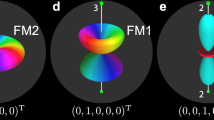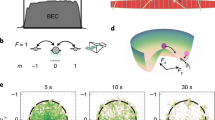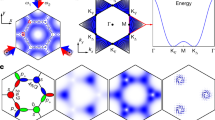Abstract
A central goal in condensed matter and modern atomic physics is the exploration of quantum phases of matter—in particular, how the universal characteristics of zero-temperature quantum phase transitions differ from those established for thermal phase transitions at non-zero temperature. Compared to conventional condensed matter systems, atomic gases provide a unique opportunity to explore quantum dynamics far from equilibrium. For example, gaseous spinor Bose–Einstein condensates1,2,3 (whose atoms have non-zero internal angular momentum) are quantum fluids that simultaneously realize superfluidity and magnetism, both of which are associated with symmetry breaking. Here we explore spontaneous symmetry breaking in 87Rb spinor condensates, rapidly quenched across a quantum phase transition to a ferromagnetic state. We observe the formation of spin textures, ferromagnetic domains and domain walls, and demonstrate phase-sensitive in situ detection of spin vortices. The latter are topological defects resulting from the symmetry breaking, containing non-zero spin current but no net mass current4.
This is a preview of subscription content, access via your institution
Access options
Subscribe to this journal
Receive 51 print issues and online access
$199.00 per year
only $3.90 per issue
Buy this article
- Purchase on Springer Link
- Instant access to full article PDF
Prices may be subject to local taxes which are calculated during checkout




Similar content being viewed by others
References
Stenger, J. et al. Spin domains in ground state spinor Bose–Einstein condensates. Nature 396, 345–348 (1998)
Ho, T.-L. Spinor Bose condensates in optical traps. Phys. Rev. Lett. 81, 742–745 (1998)
Ohmi, T. & Machida, K. Bose-Einstein condensation with internal degrees of freedom in alkali atom gases. J. Phys. Soc. Jpn 67, 1822–1825 (1998)
Saito, H., Kawaguchi, Y. & Ueda, M. Breaking of chiral symmetry and spontaneous rotation in a spinor Bose-Einstein condensate. Phys. Rev. Lett. 96, 065302 (2006)
Chang, M.-S. et al. Observation of spinor dynamics in optically trapped Rb Bose-Einstein condensates. Phys. Rev. Lett. 92, 140403 (2004)
Schmaljohann, H. et al. Dynamics of F = 2 spinor Bose-Einstein condensates. Phys. Rev. Lett. 92, 040402 (2004)
Klausen, N. N., Bohn, J. L. & Greene, C. H. Nature of spinor Bose-Einstein condensates in rubidium. Phys. Rev. A 64, 053602 (2001)
Higbie, J. M. et al. Direct, non-destructive imaging of magnetization in a spin-1 Bose gas. Phys. Rev. Lett. 95, 050401 (2005)
Pu, H. et al. Spin-mixing dynamics of a spinor Bose-Einstein condensate. Phys. Rev. A 60, 1463–1470 (1999)
Robins, N. P., Zhang, W., Ostrovskaya, E. A. & Kivshar, Y. S. Modulational instability of spinor condensates. Phys. Rev. A 64, 021601(R) (2001)
Saito, H. & Ueda, M. Spontaneous magnetization and structure formation in a spin-1 ferromagnetic Bose-Einstein condensate. Phys. Rev. A 72, 023610 (2005)
Zhang, W. et al. Dynamical instability and domain formation in a spin-1 Bose-Einstein condensate. Phys. Rev. Lett. 95, 180403 (2005)
Widera, A. et al. Coherent collisional spin dynamics in optical lattices. Phys. Rev. Lett. 95, 190405 (2005)
Chang, M.-S. et al. Coherent spinor dynamics in a spin-1 Bose condensate. Nature Phys. 1, 111–116 (2005)
Hall, D. S. et al. The dynamics of component separation in a binary mixture of Bose-Einstein condensates. Phys. Rev. Lett. 81, 1539–1542 (1998)
Miesner, H.-J. et al. Observation of metastable states in spinor Bose-Einstein condensates. Phys. Rev. Lett. 82, 2228–2231 (1999)
Stamper-Kurn, D. M. & Ketterle, W. in Coherent Matter Waves (eds Kaiser, R., Westbrook, C. & David, F.) 137–218 (Springer, New York, 2001)
Goldstein, E. V. & Meystre, P. Quasiparticle instabilities in multicomponent atomic condensates. Phys. Rev. A 55, 2935–2940 (1997)
Timmermans, E. Phase separation of Bose-Einstein condensates. Phys. Rev. Lett. 81, 5718–5721 (1997)
Kibble, T. W. B. Topology of cosmic domains and strings. J. Phys. A 9, 1387–1398 (1976)
Zurek, W. H. Cosmological experiments in superfluid helium? Nature 317, 505–508 (1985)
Zurek, W. H., Dorner, U. & Zoller, P. Dynamics of a quantum phase transition. Phys. Rev. Lett. 95, 105701 (2005)
Chuang, I., Durrer, R., Turok, N. & Yurke, B. Cosmology in the laboratory: defect dynamics in liquid crystals. Science 251, 1336–1342 (1991)
Hendry, P. C. et al. Generation of defects in superfluid 4He as an analogue of the formation of cosmic strings. Nature 368, 315–317 (1994)
Ruutu, V. M. H. et al. Vortex formation in neutron-irradiated superfluid He-3 as an analogue of cosmological defect formation. Nature 382, 334–336 (1996)
Bauerle, C. et al. Laboratory simulation of cosmic string formation in the early Universe using superfluid He-3. Nature 382, 332–334 (1996)
Isoshima, T., Machida, K. & Ohmi, T. Quantum vortex in a spinor Bose-Einstein condensate. J. Phys. Soc. Jpn 70, 1604–1610 (2001)
Mermin, N. D. & Ho, T.-L. Circulation and angular momentum in the A phase of superfluid helium-3. Phys. Rev. Lett. 36, 594–597 (1976)
Acknowledgements
We thank E. Mueller, J. Moore, and A. Vishwanath for comments, J. Guzman for experimental assistance, and the NSF and the David and Lucile Packard Foundation for financial support. S.R.L. acknowledges support from the NSERC.
Author information
Authors and Affiliations
Corresponding author
Ethics declarations
Competing interests
Reprints and permissions information is available at www.nature.com/reprints. The authors declare no competing financial interests.
Rights and permissions
About this article
Cite this article
Sadler, L., Higbie, J., Leslie, S. et al. Spontaneous symmetry breaking in a quenched ferromagnetic spinor Bose–Einstein condensate. Nature 443, 312–315 (2006). https://doi.org/10.1038/nature05094
Received:
Accepted:
Issue Date:
DOI: https://doi.org/10.1038/nature05094
This article is cited by
-
Universality class of a spinor Bose–Einstein condensate far from equilibrium
Nature Physics (2024)
-
Condensation and thermalization of an easy-plane ferromagnet in a spinor Bose gas
Nature Physics (2022)
-
Topological superfluid defects with discrete point group symmetries
Nature Communications (2022)
-
A Kerr polarization controller
Nature Communications (2022)
-
Out-of-Time-Order correlators in driven conformal field theories
Journal of High Energy Physics (2022)
Comments
By submitting a comment you agree to abide by our Terms and Community Guidelines. If you find something abusive or that does not comply with our terms or guidelines please flag it as inappropriate.



